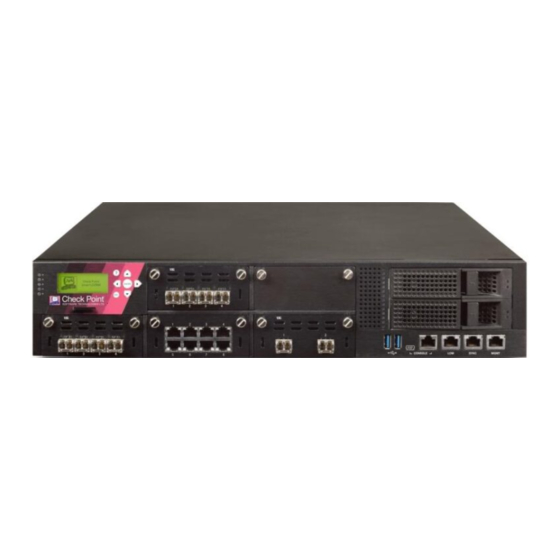
Check Point R80.20 Manuals
Manuals and User Guides for Check Point R80.20. We have 1 Check Point R80.20 manual available for free PDF download: Manual
Check Point R80.20 Manual (626 pages)
NEXT GENERATION SECURITY GATEWAY
Brand: Check Point
|
Category: Gateway
|
Size: 5 MB
Table of Contents
-
Terms16
-
ICAP Client46
-
Snmp95
-
Basic Rules109
-
Blocking Sites115
-
Sharing Layers124
-
VPN Column127
-
Content Column131
-
Actions Column132
-
Tracking Column134
-
Usercheck CLI155
-
Usercheck Client157
-
Blade Settings165
-
Ips169
-
Anti-Bot170
-
Anti-Virus171
-
Sandblast172
-
Predefined Rule180
-
Blocking Viruses185
-
Exception Rules193
-
Shared Policies198
-
Identity Sources210
-
Account Units217
-
Log Analysis223
-
Tracking Options227
-
Log Sessions229
-
Views232
-
Reports232
-
Corexl238
-
About Securexl239
-
Multi-Queue242
-
Clusterxl243
-
VRRP Cluster257
-
VSX Overview266
-
How VSX Works267
-
Virtual Devices270
-
Interfaces271
-
VSX Clusters272
-
Securing Data282
-
Overview282
-
Enabling DLP283
-
DLP Rule Base286
-
DLP Rule Actions287
-
Sample Rule Base288
-
Boot Security304
-
Comp_Init_Policy313
-
Control_Bootsec317
-
Cp_Conf320
-
Cp_Conf Auto322
-
Cp_Conf Corexl323
-
Cp_Conf Fullha325
-
Cp_Conf Ha326
-
Cp_Conf Intfs327
-
Cp_Conf Lic328
-
Cp_Conf Sic330
-
Cpconfig331
-
Cpinfo334
-
Cplic335
-
Cplic Check337
-
Cplic Contract339
-
Cplic del340
-
Cplic Print341
-
Cplic Put342
-
Cpprod_Util344
-
Cpstart347
-
Cpstat348
-
Cpstop355
-
Cpview356
-
Using Cpview356
-
Dynamic_Objects358
-
Cpwd_Admin360
-
Cpwd_Admin del365
-
Cpwd_Admin Exist367
-
Cpwd_Admin Flist368
-
Cpwd_Admin Kill370
-
Cpwd_Admin List371
-
Cpwd_Admin Exist373
-
Cpwd_Admin Start374
-
Cpwd_Admin Stop377
-
Fw -I383
-
Fw Amw384
-
Fw Ctl387
-
Fw Defaultgen436
-
Fw Fetch437
-
Fw Fetchlogs439
-
Fw Getifs441
-
Fw Hastat442
-
Fw Isp_Link444
-
Fw Kill445
-
Fw Lichosts446
-
Fw Log447
-
Fw Logswitch455
-
Fw Lslogs459
-
Fw Mergefiles462
-
Fw Monitor464
-
Fw Repairlog476
-
Fw Sam477
-
Fw Showuptables503
-
Fw Stat507
-
Fw Tab509
-
Fw Unloadlocal514
-
Fw Up_Execute517
-
Fw Ver520
-
Fwboot Bootconf521
-
Fwboot Bootconf523
-
Fwboot Corexl526
-
Fwboot Cpuid531
-
Fwboot Default533
-
Fwboot Fwdefault535
-
Fwboot Ha_Conf536
-
Fwboot Ht537
-
Fwboot Post_Drv540
-
Sam_Alert541
-
Usrchk544
-
Module 'UP575
-
Flag Description619
-
Also See the620
Advertisement
